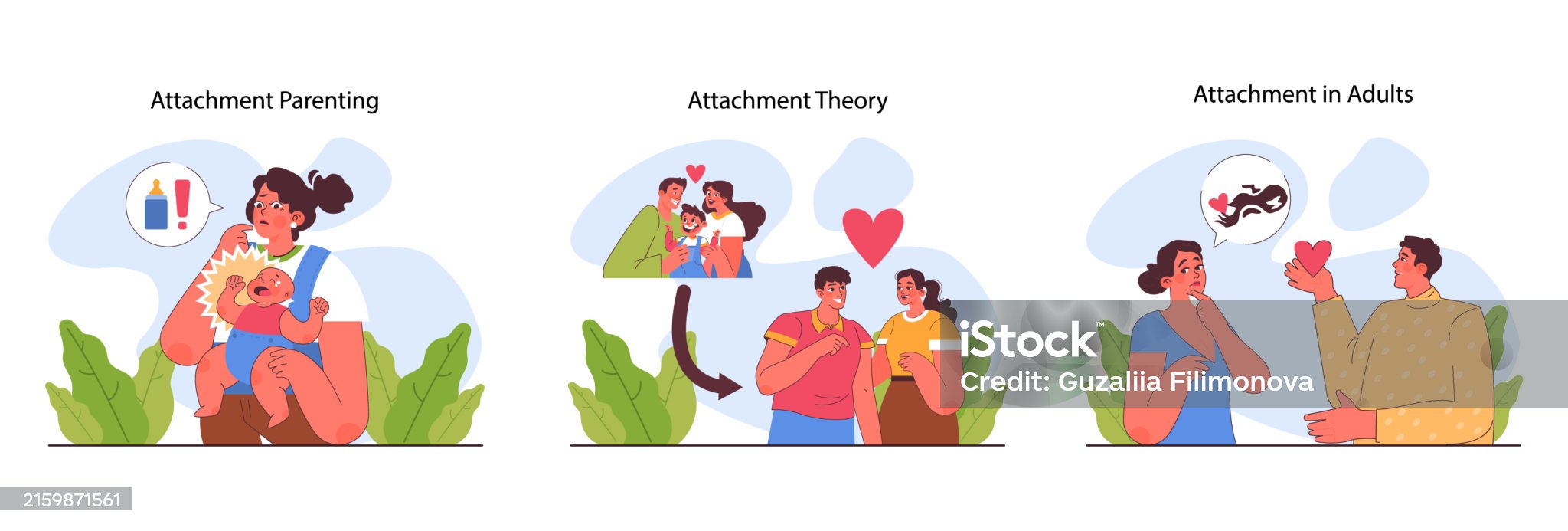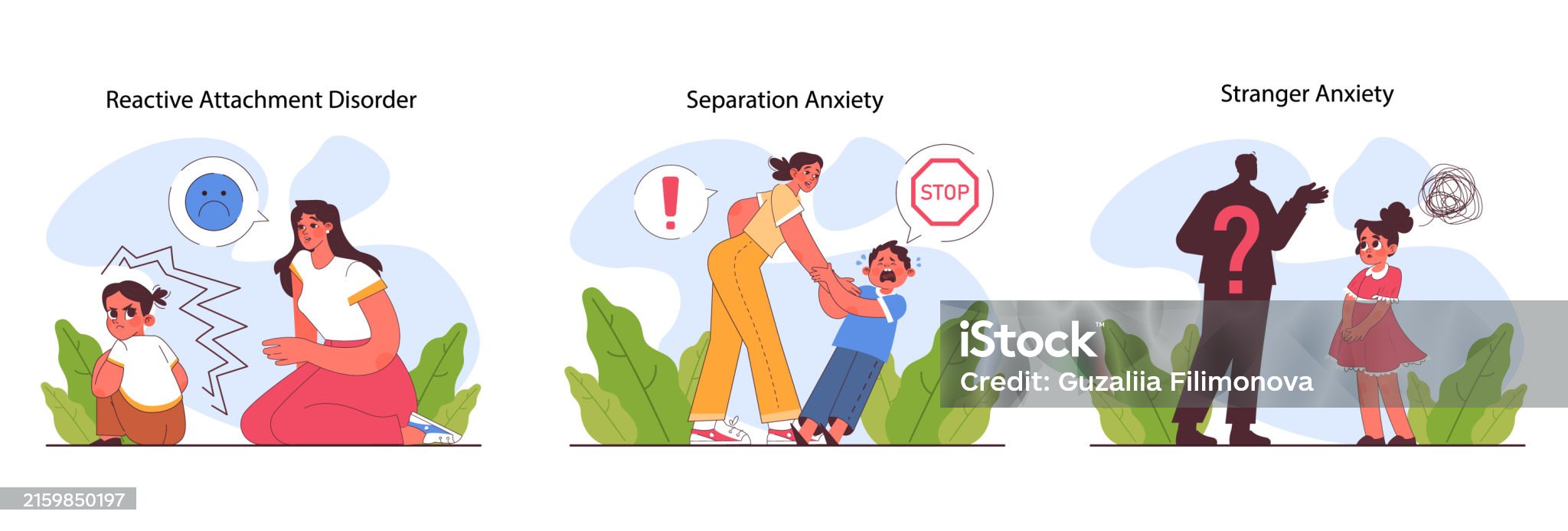Transforming lives
one step at a time

What's Your Attachment Style
What Attachment Style Do You Have?
Attachment Types
Attachment theory, developed by John Bowlby in the 1950s, proposes that the early bonds formed between children and their primary caregivers have a significant impact on their emotional and social development throughout life. This theory has been extensively researched and expanded upon, leading to the identification of four main attachment styles: secure, anxious-preoccupied, dismissive-avoidant, and fearful-avoidant.
Secure attachment is considered the healthiest style. Individuals with secure attachment typically had caregivers who were consistently responsive to their needs in childhood. As adults, they tend to have positive views of themselves and others, feel comfortable with intimacy and independence, and are more likely to form stable, satisfying relationships. They can effectively communicate their needs and emotions and are generally trusting and optimistic about relationships.
Anxious-preoccupied attachment, also known as anxious or ambivalent attachment, develops when caregivers are inconsistent in their responses to a child's needs. Adults with this attachment style often have a strong desire for closeness and intimacy but also fear abandonment. They may be overly sensitive to their partner's moods and behaviors, seeking constant reassurance and validation. These individuals may struggle with low self-esteem and tend to be hypervigilant in relationships, often interpreting neutral situations as threatening to the relationship.
Dismissive-avoidant attachment, also referred to as avoidant attachment, typically develops when caregivers are emotionally unavailable or unresponsive to a child's needs. Adults with this attachment style often have difficulty trusting others and may be uncomfortable with emotional intimacy. They tend to value their independence highly and may suppress their emotions or avoid close relationships altogether. When in relationships, they may struggle to communicate their feelings and needs effectively.
Fearful-avoidant attachment, also known as disorganized attachment, is often the result of traumatic experiences or abuse in childhood. Adults with this attachment style may simultaneously desire closeness and fear it. They often have conflicting feelings about relationships, experiencing both a strong need for connection and a fear of being hurt or rejected. This can lead to unpredictable behaviour in relationships, alternating between seeking intimacy and pushing others away.

Impact of Attachment Styles on Your Life
It's important to note that attachment styles are not fixed or deterministic. While they are often stable over time, it is possible for individuals to develop more secure attachment patterns through self-awareness, therapy, and positive relationship experiences. Understanding one's attachment style can be a valuable tool for personal growth and improving relationship dynamics. Attachment styles can significantly impact various aspects of adult life, including romantic relationships, friendships, parenting, and even professional interactions. For example, individuals with secure attachment may find it easier to maintain healthy work-life boundaries, while those with anxious attachment might struggle with workplace relationships or performance anxiety. Research has shown that attachment styles can be transmitted intergenerationally, with parents often passing on their attachment patterns to their children. However, this cycle can be broken through conscious effort and intervention. Parents who are aware of their attachment style can work to provide consistent, responsive care to their children, fostering secure attachment regardless of their own childhood experiences. The development of attachment styles is influenced by various factors, including genetics, environmental conditions, and specific experiences with caregivers. Longitudinal studies have shown that while early attachment experiences are important, later life ev ents and relationships can also shape attachment styles. Secure attachment is characterized by a positive view of both self and others. Securely attached individuals generally have high self-esteem, trust in others, and comfort with both intimacy and independence. They are able to form and maintain healthy, long-lasting relationships and can effectively communicate their needs and emotions.
Anxious-preoccupied attachment is marked by a negative view of self but a positive view of others. These individuals often have a strong fear of abandonment and may engage in clingy or demanding behavior in relationships. They tend to seek high levels of intimacy, approval, and responsiveness from their partners, which can sometimes lead to relationship difficulties.
Dismissive-avoidant attachment is characterized by a positive view of self but a negative view of others. These individuals often have high self-esteem but may struggle with trusting and depending on others. They tend to be highly self-reliant and may dismiss the importance of close relationships. In romantic partnerships, they may have difficulty with emotional intimacy and may withdraw when their partners seek closeness.
Fearful-avoidant attachment involves a negative view of both self and others. These individuals desire close relationships but fear being hurt or rejected. They may struggle with trusting others and have difficulty regulating their emotions in relationships. This attachment style is often associated with the most relationship difficulties and may require professional help to overcome.
Attachment styles can also influence how individuals cope with stress and seek support. Securely attached individuals are more likely to seek support from others when stressed, while those with avoidant attachment may withdraw and attempt to handle stress independently. Anxiously attached individuals may become overwhelmed by stress and seek excessive reassurance from others. In the context of romantic relationships, attachment styles can predict relationship satisfaction and longevity. Secure individuals tend to have the most satisfying and stable relationships, while insecure attachment styles (anxious, avoidant, and fearful) are associated with lower relationship satisfaction and higher rates of breakup or divorce. Attachment styles also play a role in parenting. Parents with secure attachment are more likely to be responsive and sensitive to their children's needs, fostering secure attachment in the next generation. In contrast, parents with insecure attachment styles may struggle to provide consistent care, potentially leading to insecure attachment in their children.
Understanding attachment styles can be particularly useful in therapy settings. Therapists can help clients identify their attachment patterns and work towards developing more secure attachment behaviours. This can involve addressing past traumas, improving communication skills, and learning to form healthier relationships. Recent research has begun to explore the neurobiological basis of attachment styles. Studies using neuroimaging techniques have found differences in brain activity and structure associated with different attachment styles, suggesting a complex interplay between early experiences, brain development, and attachment behaviours. While attachment theory provides valuable insights into human behaviour and relationships, it's essential to approach it with nuance. Attachment styles exist on a spectrum, and many individuals may not fit neatly into one category. Additionally, cultural factors can influence attachment patterns, and what is considered "secure" attachment may vary across different societies and contexts.
As with any psychological theory, attachment styles should be considered as one of many factors that influence human behavior and relationships, rather than a definitive explanation for all interpersonal dynamics. Ongoing research continues to refine our understanding of attachment styles and their impact on adult relationships, providing valuable insights for both individuals and mental health professionals.
_____________________________________________________________________
Serenity Steps recognises that while theories help us understand ourselves, life's complexities often extend beyond simple explanations.
In today's world, mental health growth and support, is no longer confined to traditional office visits or intrusive home consultations.
Using a virtual and flexible platform, Serenity Steps offers coaching, counselling, and therapeutic support to empower individuals to define, pursue, and achieve their unique life goals. This flexible platform allows clients to work towards their ideal future in an environment that feels most conducive to their progress.

References Listed By Appearance in Article:
Bowlby, J. (1969). Attachment and loss: Vol. 1. Attachment. Basic Books.
Ainsworth, M. D. S., Blehar, M. C., Waters, E., & Wall, S. (1978). Patterns of attachment: A psychological study of the strange situation.
Lawrence Erlbaum. Hazan, C., & Shaver, P. (1987). Romantic love conceptualized as an attachment process. Journal of Personality and Social Psychology, 52(3), 511-524.
Bartholomew, K., & Horowitz, L. M. (1991). Attachment styles among young adults: A test of a four-category model. Journal of Personality and Social Psychology, 61(2), 226-244.
Main, M., & Solomon, J. (1986). Discovery of an insecure-disorganized/disoriented attaVchment pattern. In T. B. Brazelton & M.
W. Yogman (Eds.), Affective development in infancy (pp. 95-124). Ablex Publishing.
Mikulincer, M., & Shaver, P. R. (2007). Attachment in adulthood: Structure, dynamics, and change.
Guilford Press. Harms, P. D. (2011). Adult attachment styles in the workplace. Human Resource Management Review, 21(4), 285-296.
Van IJzendoorn, M. H. (1995). Adult attachment representations, parental responsiveness, and infant attachment: A meta-analysis on the predictive validity of the Adult Attachment Interview.
Psychological Bulletin, 117(3), 387-403.Waters, E., Merrick, S., Treboux, D., Crowell, J., & Albersheim, L. (2000). Attachment security in infancy and early adulthood: A twenty-year longitudinal study. Child Development, 71(3), 684-689.
Feeney, J. A., & Noller, P. (1990). Attachment style as a predictor of adult romantic relationships. Journal of Personality and Social Psychology, 58(2), 281-291.
Collins, N. L., & Read, S. J. (1990). Adult attachment, working models, and relationship quality in dating couples. Journal of Personality and Social Psychology, 58(4), 644-663.
Fraley, R. C., & Shaver, P. R. (2000). Adult romantic attachment: Theoretical developments, emerging controversies, and unanswered questions. Review of General Psychology, 4(2), 132-154.
Bartholomew, K., & Shaver, P. R. (1998). Methods of assessing adult attachment. In J. A. Simpson & W. S. Rholes (Eds.), Attachment theory and close relationships (pp. 25-45). Guilford Press.
Mikulincer, M., & Florian, V. (1998). The relationship between adult attachment styles and emotional and cognitive reactions to stressful events. In J. A. Simpson & W. S.
Rholes (Eds.), Attachment theory and close relationships (pp. 143-165). Guilford Press.Feeney, J. A. (2008). Adult romantic attachment: Developments in the study of couple relationships. In J. Cassidy & P. R. Shaver (Eds.), Handbook of attachment: Theory, research, and clinical applications (2nd ed., pp. 456-481). Guilford Press.
George, C., & Solomon, J. (2008). The caregiving system: A behavioral systems approach to parenting. In J. Cassidy & P. R. Shaver (Eds.), Handbook of attachment: Theory, research, and clinical applications (2nd ed., pp. 833-856). Guilford Press.
Johnson, S. M. (2004). The practice of emotionally focused couple therapy: Creating connection (2nd ed.). Brunner-Routledge.
Vrticka, P., & Vuilleumier, P. (2012). Neuroscience of human social interactions and adult attachment style. Frontiers in Human Neuroscience, 6, 212.
Rothbaum, F., Weisz, J., Pott, M., Miyake, K., & Morelli, G. (2000). Attachment and culture: Security in the United States and Japan. American Psychologist, 55(10), 1093-1104.
Fraley, R. C. (2019). Attachment in adulthood: Recent developments, emerging debates, and future directions. Annual Review of Psychology, 70, 401-422.



